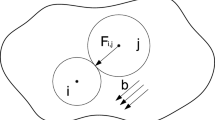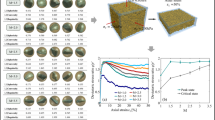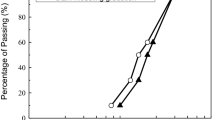Abstract
The discrete element method (DEM) is widely used for the simulation of ballast behavior under static and dynamic loading conditions. Due to the irregular shape of ballast particles, the simultaneous influence of multiple parameters (i.e., static and rolling friction coefficients, Young's modulus, Poisson's ratio, and restitution coefficient) should be considered when calibrating DEM input parameters for ballast particles, which poses a challenge. To reduce the influence of shape factors on the bulk behavior of ballast samples, a series of clumps for describing the shape of particles comprised of 17–24 balls are first created and generated. In the following, an efficient calibration method is proposed with four different tests, including the hollow cylinder test, confined compression test, direct shear test, and ballast box test. The order of the implemented tests is important due to the effect of the variation of friction coefficients on the results of all tests. Since the angle of the repose test is insignificantly influenced by contact and damping parameters due to the lack of external force on the ballast sample, firstly, the calibration of particle friction coefficients is performed by several repose angle tests. Thereafter, the direct shear test is used to calibrate particle Young's modulus and Poisson's ratio. Finally, the restitution coefficient of particles is calibrated by DEM modeling of ballast box tests under cyclic loading. The proposed method would be helpful for the calibration of ballast particle properties which is a necessary stage before the simulation of any experiments.










Similar content being viewed by others
References
Jing L, Stephansson O (2007) Fundamentals of discrete element methods for rock engineering: theory and applications. Elsevier
Cundall PA, Strack ODL (1979) A discrete numerical model for granular assemblies. Géotechnique 29:47–65. https://doi.org/10.1680/geot.1979.29.1.47
Shi X, Polycarpou AAJJVA (2005) Measurement and modeling of normal contact stiffness and contact damping at the meso scale. J Vib Acoust 127:52–60
Hong DC, McLennan JA (1992) Molecular dynamics simulations of hard sphere granular particles. Physica A 187:159–171. https://doi.org/10.1016/0378-4371(92)90416-N
E111–17 A (2017) Standard test method for Young’s modulus, tangent modulus, and chord modulus. ASTM International
Elata D, Berryman JGJMM (1996) Contact force-displacement laws and the mechanical behavior of random packs of identical spheres. Mech Mater 24:229–240
Jing G, Aela P, Fu H (2019) The contribution of ballast layer components to the lateral resistance of ladder sleeper track. Construct Build Mater 202:796–805
Wang Y, Mora P, Liang Y (2022) Calibration of discrete element modeling: scaling laws and dimensionless analysis. Particuology 62:55–62. https://doi.org/10.1016/j.partic.2021.03.020
Thornton C, Cummins SJ, Cleary PW (2013) An investigation of the comparative behaviour of alternative contact force models during inelastic collisions. Powder Technol 233:30–46. https://doi.org/10.1016/j.powtec.2012.08.012
Mindlin RDJJAM (1953) Elastic spheres in contact under varying oblique forces. J Appl Mech 20:327–344
Liu X, Gui N, Cui X, Yang X, Tu J, Jiang S (2022) Discrete element-embedded finite element model for simulation of soft particle motion and deformation. Particuology 68:88–100. https://doi.org/10.1016/j.partic.2021.10.008
O’Sullivan C, Bray Jonathan D (2004) Selecting a suitable time step for discrete element simulations that use the central difference time integration scheme. Eng Comput 21:278–303. https://doi.org/10.1108/02644400410519794
Guide. EU (2018) DEM Solutions Ltd., Edinburgh, Scotland, UK. Copyright ©.
Yan Z, Wilkinson S, Stitt E, Marigo MJCPM (2015) Discrete element modelling (DEM) input parameters: understanding their impact on model predictions using statistical analysis. Comput Part Mech 2:283–299
Gelnar D and Zegzulka J (2019) Discrete element method in the design of transport systems: verification and validation of 3D models. Springer
Thornton C, Randall CW (1988) Applications of theoretical contact mechanics to solid particle system simulation In: Satake M, Jenkins JT (eds) Studies in applied mechanics. Elsevier, pp 133–142
Zhang X, Zhao C, Zhai WJSD (2019) Importance of load frequency in applying cyclic loads to investigate ballast deformation under high-speed train loads. Soil Dyn Earthq Eng 120:28–38
Guo Y, Zhao C, Markine V, Jing G, Zhai W (2020) Calibration for discrete element modelling of railway ballast: a review. Trans Geotech. https://doi.org/10.1016/j.trgeo.2020.100341
Xiao J, Zhang X, Zhang D, Xue L, Sun S, Stránský J, Wang Y (2020) Morphological reconstruction method of irregular shaped ballast particles and application in numerical simulation of ballasted track. Trans Geotech 24:100374. https://doi.org/10.1016/j.trgeo.2020.100374
Guo Y, Markine V, Song J, Jing G (2018) Ballast degradation: effect of particle size and shape using Los Angeles Abrasion test and image analysis. Constr Build Mater 169:414–424. https://doi.org/10.1016/j.conbuildmat.2018.02.170
Valera RLR, González JI, de Oliveira JM, de Farias MM, Fuentes MAC, Martínez RT, Aguila JP, Anselmi LAM, Morfa CAR, Oñate E (2022) Development and coupling of numerical techniques for modeling micromechanical discrete and continuous media using real particle morphologies. Comput Particle Mech. https://doi.org/10.1007/s40571-022-00481-x
Pérez Morales I, Roselló Valera R, RecareyMorfa C, Muniz de Farias M (2017) Dense packing of general-shaped particles using a minimization technique. Comput Particle Mech 4:165–179. https://doi.org/10.1007/s40571-016-0103-x
Danesh A, Mirghasemi AA, Palassi M (2020) Evaluation of particle shape on direct shear mechanical behavior of ballast assembly using discrete element method (DEM). Trans Geotech 23:100357. https://doi.org/10.1016/j.trgeo.2020.100357
Liu Y, Zhou X, You Z, Yao S, Gong F, Wang H (2017) Discrete element modeling of realistic particle shapes in stone-based mixtures through MATLAB-based imaging process. Constr Build Mater 143:169–178. https://doi.org/10.1016/j.conbuildmat.2017.03.037
Peng Y, Li T, Zhu Z, Zou S, Yin Z (2017) Discrete element method simulations of load behavior with mono-sized iron ore particles in a ball mill. Adv Mech Eng. https://doi.org/10.1177/1687814017705597
Zhang Z-T, Gao W-H, Wang X, Zhang J-Q, Tang X-Y (2020) Degradation-induced evolution of particle roundness and its effect on the shear behaviour of railway ballast. Trans Geotech 24:100388. https://doi.org/10.1016/j.trgeo.2020.100388
Gröger T, Katterfeld A (2006) On the numerical calibration of discrete element models for the simulation of bulk solids In: Marquardt W, Pantelides C (eds) Computer aided chemical engineering. Elsevier, pp 533–538
Coetzee CJ (2017) Review: calibration of the discrete element method. Powder Technol 310:104–142. https://doi.org/10.1016/j.powtec.2017.01.015
Zhang J, Wang X, Yin Z-Y, Liang Z (2020) DEM modeling of large-scale triaxial test of rock clasts considering realistic particle shapes and flexible membrane boundary. Eng Geol 279:105871. https://doi.org/10.1016/j.enggeo.2020.105871
Katterfeld A, Donohue T, Ilic D (2012) Application of the discrete element method in mechanical conveying of bulk materials. In: 7th International conference for conveying and handling of particulate solids (ChoPS), pp 10–13
Ahmad M, Khairul Azwan I, Mat F (2016) Impact models and coefficient of restitution: a review
Wei H, Zan L, Li Y, Wang Z, Saxén H, Yu Y (2017) Numerical and experimental studies of corn particle properties on the forming of pile. Powder Technol 321:533–543. https://doi.org/10.1016/j.powtec.2017.08.051
Ye F, Wheeler C, Chen B, Hu J, Chen K, Chen W (2019) Calibration and verification of DEM parameters for dynamic particle flow conditions using a backpropagation neural network. Adv Powder Technol 30:292–301. https://doi.org/10.1016/j.apt.2018.11.005
Katterfeld A, Roessler T (2019) Standard procedure for the calibration of DEM parameters of cohesionless bulk materials
Coetzee C (2020) Calibration of the discrete element method: Strategies for spherical and non-spherical particles. Powder Technol 364:851–878. https://doi.org/10.1016/j.powtec.2020.01.076
Horabik J, Beczek M, Mazur R, Parafiniuk P, Ryżak M, Molenda MJBE (2017) Determination of the restitution coefficient of seeds and coefficients of visco-elastic Hertz contact models for DEM simulations. Granular Matter 161:106–119
Indraratna B, Hussaini SKK, Vinod J (2013) The lateral displacement response of geogrid-reinforced ballast under cyclic loading. Geotext Geomembr 39:20–29
Esmaeili M, Aela P, Hosseini A (2017) Experimental assessment of cyclic behavior of sand-fouled ballast mixed with tire derived aggregates. Soil Dyn Earthq Eng 98:1–11
Li H, McDowell G (2020) Discrete element modelling of two-layered ballast in a box test. Granular Matter 22:76. https://doi.org/10.1007/s10035-020-01046-6
Al-Hashemi HMB, Al-Amoudi OSBJPT (2018) A review on the angle of repose of granular materials. Powder Technol 330:397–417
Jing G, Ji Y, Aela P (2020) Experimental and numerical analysis of anchor-reinforced sleepers lateral resistance on ballasted track. Constr Build Mater 264:120197. https://doi.org/10.1016/j.conbuildmat.2020.120197
Jing G, Aela P, Fu H, Yin H (2018) Numerical and experimental analysis of single tie push tests on different shapes of concrete sleepers in ballasted tracks. Proc Inst Mech Eng F J Rail Rapid Trans
Mehta A, Barker GC (1994) The dynamics of sand. Rep Prog Phys 57:383–416. https://doi.org/10.1088/0034-4885/57/4/002
Li T, Peng Y, Zhu Z, Zou S, Yin Z (2017) Discrete element method simulations of the inter-particle contact parameters for the mono-sized iron ore particles. Materials (Basel) 10:520. https://doi.org/10.3390/ma10050520
Müser MH, Wenning L, Robbins MOJPRL (2001) Simple microscopic theory of Amontons’s laws for static friction. Phys Rev Lett 86:1295
Irazábal J, Salazar F, Oñate E (2017) Numerical modelling of granular materials with spherical discrete particles and the bounded rolling friction model. Application to railway ballast. Comput Geotech 85:220–229
Ngo NT, Indraratna B, Rujikiatkamjorn C, Biabani MM (2016) Experimental and discrete element modeling of geocell-stabilized subballast subjected to cyclic loading. J Geotech Geoenviron Eng 142:04015100. https://doi.org/10.1061/(ASCE)GT.1943-5606.0001431
Barrios GKP, de Carvalho RM, Kwade A, Tavares LM (2013) Contact parameter estimation for DEM simulation of iron ore pellet handling. Powder Technol 248:84–93. https://doi.org/10.1016/j.powtec.2013.01.063
Zhao J, Müller D, Takahashi Y, Kaneda Y (2004) 3-D finite-element modelling of deformation and stress associated with faulting: effect of inhomogeneous crustal structures. Geophys J Int 157:629–644. https://doi.org/10.1111/j.1365-246X.2004.02200.x
Kulhawy FHJEG (1975) Stress deformation properties of rock and rock discontinuities. Eng Geol 9:327–350
Aela P, Zong L, Esmaeili M, Siahkouhi M, Jing G (2022) Angle of repose in the numerical modeling of ballast particles focusing on particle-dependent specifications: Parametric study. Particuology 65:39–50. https://doi.org/10.1016/j.partic.2021.06.006
Rackl M, Grötsch FE (2018) 3D scans, angles of repose and bulk densities of 108 bulk material heaps. Sci Data 5:180102. https://doi.org/10.1038/sdata.2018.102
Rojek J (2018) Contact modeling in the discrete element method. In: Wriggers P (ed) Popp A. Contact modeling for solids and particles Springer International Publishing, Cham, pp 177–228
Norouzi HR, Zarghami R, Sotudeh-Gharebagh R, Mostoufi N (2016) Coupled CFD-DEM modeling: formulation, implementation and application to multiphase flows. Wiley
Liu J, Wang P, Liu G, Zhang M, Xiao J, Liu HJC, Materials B (2020) Uniaxial compression characteristics of railway ballast combined with ice. Construct Build Mater 263:120554
Jing G, Wang J, Wang H, Siahkouhi M (2020) Numerical investigation of the behavior of stone ballast mixed by steel slag in ballasted railway track. Constr Build Mater 262:120015. https://doi.org/10.1016/j.conbuildmat.2020.120015
Selig ET, Yoo TS, Panuccio CM (1982) Mechanics of ballast compaction volume 2: field methods for ballast physical state measurement. United States Federal Railroad Administration
Estaire J, Santana M (2018) Large direct shear tests performed with fresh ballast railroad ballast testing and properties. ASTM International
Guo Y, Zhao C, Markine V, Shi C, Jing G, Zhai W (2020) Discrete element modelling of railway ballast performance considering particle shape and rolling resistance. Railway Eng Sci 28:382–407. https://doi.org/10.1007/s40534-020-00216-9
Indraratna B, Ngo T, Rujikiatkamjorns CJIJOG (2019) Performance of ballast influenced by deformation and degradation: laboratory testing and numerical modeling. Int J Geomech 20:04019138
Acknowledgements
This study is supported by the China Academy of Railway Science funding (2020YJ081) and the GRF project (Grant No. 15220221) from the Research Grants Council (RGC) of Hong Kong.
Author information
Authors and Affiliations
Corresponding author
Additional information
Publisher's Note
Springer Nature remains neutral with regard to jurisdictional claims in published maps and institutional affiliations.
Rights and permissions
Springer Nature or its licensor holds exclusive rights to this article under a publishing agreement with the author(s) or other rightsholder(s); author self-archiving of the accepted manuscript version of this article is solely governed by the terms of such publishing agreement and applicable law.
About this article
Cite this article
Aela, P., Zong, L., Yin, ZY. et al. Calibration method for discrete element modeling of ballast particles. Comp. Part. Mech. 10, 481–493 (2023). https://doi.org/10.1007/s40571-022-00507-4
Received:
Revised:
Accepted:
Published:
Issue Date:
DOI: https://doi.org/10.1007/s40571-022-00507-4




